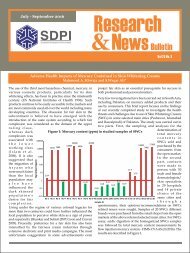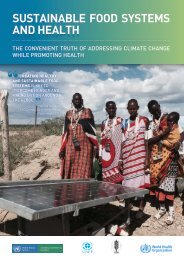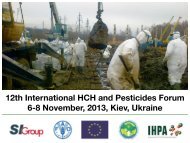Women and Chemicals
WomenAndChemicals_PublicationIWD2016
WomenAndChemicals_PublicationIWD2016
You also want an ePaper? Increase the reach of your titles
YUMPU automatically turns print PDFs into web optimized ePapers that Google loves.
Existing initiatives<br />
SAICM Ind. No. 7: Communicating<br />
information on the risks associated<br />
with chemicals to vulnerable groups<br />
100 %<br />
80 %<br />
60 %<br />
40 %<br />
20 %<br />
0 %<br />
ICCA (2012) 2nd Update Report for the UN SAICM Implementation Indicators<br />
sponsible Care Charter, which is the global chemical industry`s<br />
environmental, health <strong>and</strong> safety initiative, does not refer to<br />
women or gender. However, the ICCA 2 nd update report on SA-<br />
ICM indicators 10 shows that many companies fail to achieve SA-<br />
ICM indicator 7, which lists those countries (<strong>and</strong> organisations)<br />
that have specific strategies in place for communicating information<br />
on the risks associated with chemicals to vulnerable groups.<br />
For a greater impact, the data collection should also include consultative<br />
processes <strong>and</strong> training directed at vulnerable groups,<br />
such as women, children, the elderly <strong>and</strong> migrant workers, <strong>and</strong><br />
take into consideration social <strong>and</strong> economic conditions. Clearly<br />
there is a need for more information <strong>and</strong> awareness raising<br />
among companies to recognize this important issue, <strong>and</strong> take<br />
measures in order to achieve the 2020 goal of SAICM.<br />
Governments<br />
Updated<br />
In Development<br />
‘09 ‘11<br />
WEOG<br />
‘09 ‘11 ‘09 ‘11<br />
CEE LAC<br />
Region<br />
Completed<br />
No Progress<br />
‘09 ‘11<br />
APAC<br />
The activities of governments on the issue of chemicals <strong>and</strong><br />
women reflect the wide range <strong>and</strong> diversity of aspects to be<br />
addressed. They range from legislative action protecting women<br />
from hazardous chemicals <strong>and</strong> information campaigns on<br />
the issue to activities in international multi-stakeholder initiatives.<br />
In most cases the activities are embedded in broader<br />
fields like occupational health, gender mainstreaming, <strong>and</strong><br />
chemicals management. This fact makes it difficult to gain a<br />
comprehensive overview.<br />
Some countries have policies in place on e.g. maternal<br />
health, but still difficulties can occur. Breadley describes that<br />
in Canada, “maternal health protection is provided through a<br />
mosaic of federal <strong>and</strong> provincial/territorial legislation <strong>and</strong><br />
regulation <strong>and</strong> individual workplace policies. The result of<br />
these separate spheres is that there are gaps, overlaps <strong>and</strong><br />
contradictions between <strong>and</strong> among federal, provincial <strong>and</strong><br />
territorial legislation.” 11 The same can be stated for many<br />
countries worldwide.<br />
Yet some governments recently took specific measures to<br />
inform <strong>and</strong> protect pregnant women from exposure to endocrine<br />
disrupting chemicals. Denmark is one of the pioneers with<br />
its awareness-raising campaign that informs pregnant women<br />
about hazardous chemicals <strong>and</strong> their potential impact on the<br />
health of their developing babies. 12 In Austria, pregnant women<br />
can find information via an online brochure. 13<br />
In December 2013, France passed a bill banning Bisphenol A,<br />
a known endocrine disruptor, in food contact materials. The ban<br />
took effect in January 2013 for all food contact materials for children<br />
under the age of three years; <strong>and</strong> by January 2015 for pacifiers<br />
<strong>and</strong> teething rings. In the interim, a warning label for pregnant<br />
women indicating Bisphenol A (BPA) as an ingredient in a<br />
specific product, was designed to make it possible for people to<br />
reduce their exposure. Moreover, the law also bans the use of<br />
DEHP, a reprotoxic phthalate, in infusion tubes used in neonatology<br />
departments <strong>and</strong> by pregnant <strong>and</strong> breastfeeding women,<br />
from January 2015.<br />
The EU has a directive protecting women from hazardous<br />
chemicals at the workplace while being pregnant, directly after<br />
given birth <strong>and</strong> while breastfeeding. This directive includes a<br />
broad range of chemicals. However, it lacks endocrine disrupting<br />
substances.<br />
As stated, it is difficult to get a significant overview on all initiatives<br />
of governments. A good indicator is the first SAICM report<br />
on the progress in the implementation of the Strategic Approach:<br />
Results of preliminary data collection for 2009 <strong>and</strong> 2010. 14<br />
For this report countries have been asked to share any specific<br />
communication strategies by which they would raise awareness<br />
on the risks associated with chemicals to vulnerable groups.<br />
From the 92 responses, not only countries but also other stakeholders,<br />
more than 40 per cent claimed to communicate chemical<br />
safety to women.<br />
However, the governments were not obliged to share the<br />
content of these strategies. To take a further step, it would be<br />
well worth to amend the questionnaire used for this report <strong>and</strong><br />
ask for more specific information about the activities taken.<br />
59







